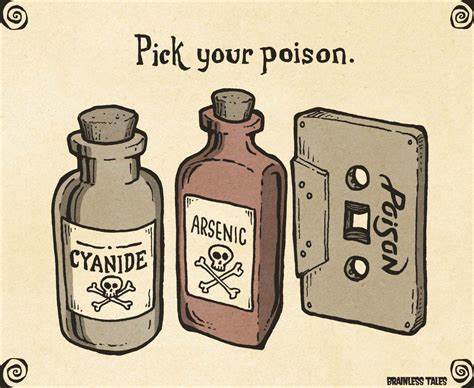Introduction
Cartoons have been a staple of entertainment for children and adults alike, often providing laughter, adventure, and moral lessons through vibrant animation and engaging storylines. Among the various themes explored in cartoons, the concept of poison has played a unique and intriguing role. Poison in cartoons is frequently used as a plot device to introduce danger, conflict, and suspense, often leading to dramatic rescues or lessons learned. This article delves into the depiction of poison in cartoons, exploring its historical context, narrative functions, and the messages conveyed to audiences.
Historical Context
Early Depictions
The use of poison in storytelling is not a recent phenomenon. It has been a common trope in literature, folklore, and theatre for centuries, often symbolizing treachery, danger, and mystery. Early cartoons, influenced by these traditional narratives, incorporated poison into their plots as a way to introduce high stakes and dramatic tension.
Golden Age of Animation
During the Golden Age of Animation (1920s-1960s), major studios like Disney, Warner Bros., and MGM produced numerous cartoons that featured poison in various forms. From potions and poisons concocted by wicked witches to sinister plots by villainous characters, poison became a versatile tool for animators to create engaging and suspenseful stories.
Narrative Functions of Poison in Cartoons
Introducing Conflict
Poison is often used in cartoons to introduce conflict and set the stage for the hero’s journey. The presence of poison creates immediate danger, forcing the protagonist to act swiftly and decisively. For instance, in many classic Disney films, poison is used by antagonists to harm the protagonists or their loved ones, compelling the heroes to embark on quests to find antidotes or reverse the effects.
Highlighting Villainy
The use of poison is a hallmark of villainous behavior in cartoons. Characters who resort to poison are typically portrayed as deceitful and malicious, contrasting sharply with the noble and virtuous heroes. This clear delineation between good and evil helps young audiences understand moral values and the consequences of harmful actions.
Creating Suspense and Drama
Poison adds an element of suspense and drama to cartoon narratives. The ticking clock associated with finding an antidote or preventing the spread of poison heightens tension and keeps audiences on the edge of their seats. This narrative device is particularly effective in episodic cartoons, where cliffhangers and ongoing plots maintain viewer interest.
Teaching Moral Lessons
Many cartoons use poison as a means to impart moral lessons. The consequences of using or being affected by poison often lead to reflections on trust, responsibility, and the importance of making ethical choices. For example, episodes where characters learn the dangers of tampering with unknown substances or the importance of seeking help in emergencies provide valuable lessons for young viewers.
Iconic Examples of Poison in Cartoons
“Snow White and the Seven Dwarfs” (1937)
One of the most iconic uses of poison in animation history is found in Disney’s “Snow White and the Seven Dwarfs.” The Evil Queen’s poisoned apple, given to Snow White, is a classic example of poison as a plot device. The dramatic consequences of the poisoned apple and the subsequent rescue by Prince Charming emphasize themes of good versus evil and the power of true love.
“The Road Runner Show” (1949-1973)
In the classic “Road Runner” cartoons, Wile E. Coyote frequently resorts to elaborate and often comically ineffective schemes to catch the Road Runner, including the use of various poisons. These episodes highlight the futility of underhanded tactics and the resilience of the Road Runner, reinforcing the idea that persistence and cunning are no match for inherent wit and agility.
“The Simpsons” (1989-present)
In more contemporary cartoons like “The Simpsons,” poison is sometimes used in a satirical context. The show’s dark humor often involves characters encountering or using poison in absurd and exaggerated situations. These episodes serve to parody the tropes of older cartoons while also providing commentary on modern society’s fears and anxieties.
“Batman: The Animated Series” (1992-1995)
“Batman: The Animated Series” frequently features poison in its storylines, particularly through the character of Poison Ivy. Ivy’s use of plant-based toxins and her environmentalist agenda add complexity to her character, making her both a formidable adversary and a sympathetic figure. The show’s nuanced portrayal of poison reflects its more mature themes and target audience.
Messages and Morals
The Consequences of Malice
Cartoons often use poison to illustrate the consequences of malicious actions. Characters who use poison for nefarious purposes typically face justice by the end of the story, reinforcing the idea that wrongdoing is ultimately punished. This serves as a deterrent against harmful behavior and promotes ethical conduct.
The Importance of Caution
Many cartoons emphasize the importance of caution when dealing with unknown substances. Episodes where characters accidentally poison themselves or others highlight the dangers of carelessness and encourage viewers to be mindful of their actions. This message is particularly relevant for young audiences who may encounter potentially hazardous situations in real life.
The Power of Goodness
Despite the presence of poison and other dangers, cartoons often celebrate the power of goodness and virtue. Heroes who confront and overcome the threat of poison through bravery, intelligence, and kindness demonstrate the triumph of positive qualities over malevolence. This reinforces the value of maintaining integrity and compassion in the face of adversity.
The Evolution of Poison in Cartoons
Changing Perspectives
As societal attitudes and cultural norms evolve, so too does the depiction of poison in cartoons. Modern animations are more likely to present poison in a context that encourages critical thinking and problem-solving. Rather than simply serving as a plot device, poison in contemporary cartoons may be used to explore complex themes such as environmentalism, justice, and the consequences of scientific experimentation.
Educational Elements
Today’s cartoons often incorporate educational elements when depicting poison. Shows aimed at younger audiences may include safety tips and explanations of how to handle dangerous substances responsibly. This approach not only entertains but also educates, providing practical knowledge alongside fictional narratives.
Diverse Storytelling
The diversity of storytelling in modern animation has expanded the ways in which poison is used in cartoons. From fantasy adventures to sci-fi thrillers, poison can take many forms and serve various narrative purposes. This diversity reflects the broadening scope of animation as a medium capable of tackling a wide range of topics and genres.
Conclusion
Poison in cartoons has been a versatile and enduring narrative device, shaping the stories and lessons of countless animated tales. From its early use in classic Disney films to its more nuanced portrayal in contemporary series, poison continues to captivate audiences with its potential for drama, conflict, and moral teaching. As animation evolves, so too will the ways in which poison is depicted, ensuring that this intriguing element remains a staple of cartoon storytelling for generations to come.







